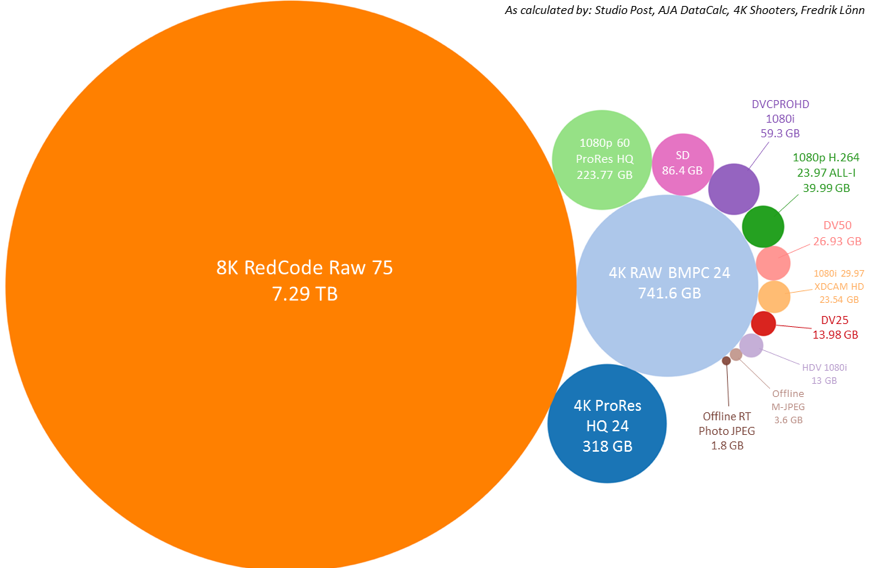File Size Growth & The Bandwidth Conundrum
It is no surprise to anyone within Media & Entertainment that video file sizes are getting larger — much larger. Increased image resolution and other picture improvement technologies can significantly enhance the viewer experience, but they all increase the amount of data required to deliver a minute of video.
File sizes will continue to grow
4K video is a primary source of file size growth as more and more productions are done entirely in 4K. As with the transition from SD to HD, the availability of 4K video content to consumers naturally lags adoption in production. But that, too, is starting to happen, with rapid growth in specific content categories like premium live sports and long-form scripted dramas on SVOD platforms such as Netflix and Amazon. The rollout of ATSC 3.0, FCC’s next generation transmission standard, has also accelerated 4K distribution of television, since almost a quarter of U.S. homes still receive broadcasts over the air.
Between 4K streaming providers, the popularity of 4K videogame consoles, and the growing availability of 4K UHD Blu-Ray discs, there is ample reason for consumers to buy 4K UHD TVs. In fact, Futuresource Consulting’s 2019 Worldwide TV Market Report reported that 4K UHD TV sales hit 105m in 2018, up 32% from the previous year.
8k buzz seems to have died down, but…
While the initial buzz of 8k seems to have died down, Futuresource also estimates that 8k adoption will grow to form a significant part of the premium TV market by 2023. As fringe as it seems, we are still witnessing more high-end productions in 8K.
Japan’s NHK launch the world’s first 8K TV channel in December of 2018. Some panel makers, especially in Asia, are already adding 8K resolution to their future roadmaps and product plans, with the first consumer models likely to appear in the next couple of years.
What does 4k/8k mean for file sizes?
The file size implications of the transition from older resolutions to 4K and 8K are exponential. In the graphic below, each circle represents one hour of video for the specified format.
One hour of 8K RedCode Raw 75 amounts to 7.29 TB. That’s 121.5 GB per minute for raw 8K footage.

Other drivers of video file size growth
Increased resolution is not the only driver of larger file sizes. New picture improvement technologies such as High Dynamic Range (HDR) and Wide Color Gamut (WCG), along with higher frame rates and deeper color depth, are also all significantly increasing the size of video files.
Impact on production and distribution
For companies in the business of producing and/or distributing content, increases in file size create all sorts of technical challenges. Much more storage is required, rendering becomes even more compute-intensive, and moving the files around the world becomes very challenging.
Within the media world, the solution to the problem of moving ever-larger files in a timely manner is well established. There are two key elements:
- Increase the IP network bandwidth in and out of facilities.
- Deploy UDP-based acceleration software to ensure full utilization of that bandwidth.
The need for UDP-based acceleration is driven by the fact that conventional protocols like TCP and FTP don’t work optimally when large files and long distances are involved. Latency and network congestion gum up the works, slowing down transfers and negating the benefits of added bandwidth. By using a more advanced transport protocol such as Signiant’s, the impact of these factors is minimized and the entire pipe can be filled with data — thereby ensuring that the files get from Point A to Point B much faster. (To understand how this works in practice check out our File Transfer Calculator.)
The economics of increased bandwidth
The technical aspects of adding bandwidth and deploying acceleration software are well understood, but the financial implications can be surprisingly convoluted.
Here’s the problem. Quite logically, network providers charge more money for more bandwidth. Media companies understand that there are real costs associated with additional connectivity and expect to pay more. What can come as an unpleasant surprise, however, is that some acceleration software vendors will hold that bandwidth hostage. By employing a bandwidth-based pricing model, they will only enable full utilization of additional bandwidth if the customer pays a premium. These additional costs can be significant and unplanned, making the bandwidth upgrade more financially painful than it needs to be.
At Signiant, our commitment to being ‘easy to do business with’ extends to our pricing model. Customers tell us they don’t like bandwidth-based pricing and we have never employed it.
Signiant never charges based on bandwidth
Our position is that customers should not be penalized for upgrading the connectivity needed to improve their business operations and speed up their critical file movements. We prefer pricing based on the actual usage of our solutions, not on the enabling infrastructure over which our solutions are deployed.
Each of our products has a different pricing model that aligns with the target use cases:
- Media Shuttle, a cloud-native SaaS solution for person-initiated sending and sharing of large files, is sold as a subscription based on the number of active users. Each subscription also comes with a cloud payload allotment in case the customer wants to deploy some portals in AWS or Azure.
- Jet, a unique SaaS solution for fast and reliable automated transfers, scales to the needs and budgets of small and mid-sized companies that regularly exchange files between locations and partners. It is often used to replace scripted FTP.
- Flight Deck combines the robust features of Manager+Agents with the advanced cloud I/O capabilities of Signiant Flight, creating the essential transport backbone for many of the world’s leading media companies. Its cloud-connected functionalities, including seamless visibility through the Signiant console used by Media Shuttle and Jet, elevate automated file movement to the gold standard in the SaaS era.


